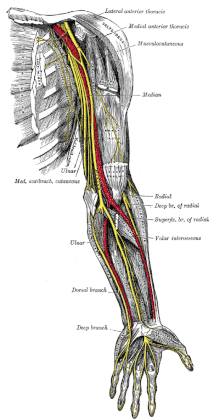Ulnar Channel Syndrome
| Classification according to ICD-10 | |
|---|---|
| G56.2 | Ulnar nerve lesion |
| ICD-10 online (WHO version 2019) | |
The ulnar channel syndrome ( synonyms ulnar channel syndrome , sulcus ulnaris syndrome or cubital tunnel syndrome ) is pressure damage to the ulnar nerve on the elbow .
Ulnar nerve
The ulnar nerve ("ulnar nerve") runs in the area of the elbow in a well palpable groove ( sulcus ulnaris ), protected only by a little connective tissue , in direct contact with the ulna and directly under the skin. You can therefore easily locate it yourself by touching it and usually trigger a tingling sensation or burning sensation in the hand with just a light touch. As a result, this region is very sensitive to pain even if it is lightly bumped, which has given it the name "musician bones" (also known as "music bones", "musicians bones", "little mice"). In Austria one often speaks of the "foolish boa (foolish leg)" or the "damischen aderle".
causes
Because the nerve is so unprotected at this point, it is prone to injury from pressure and tension. Repetitive movements or constant strain can cause irritation and eventually damage to the nerve.
Symptoms
The nerve damage becomes noticeable through a feeling of numbness in the little finger, on the outer side of the ring finger and in the adjacent palm area of the corresponding arm. Motor weakness of the supplied muscles in the affected hand and ultimately muscle wasting can occur. This leads to limited mobility of the hand. The little finger and ring finger get into the flexed position of the end joints when the base joint is overstretched and it is difficult to spread the fingers ( claw or claw hand ).
diagnosis
A neurologist can usually make the diagnosis based on the description of the symptoms, but clinical (testing of muscle strength and sensation of touch) and electrophysiological examinations, for example measuring nerve conduction velocities , are essential. The Froment sign is positive.
Differential diagnosis
In the differential diagnosis, damage to the ulnar nerve on the wrist ( Loge de Guyon syndrome ) must be excluded.
Multiple and differently localized effects on the nerves ( double crush syndrome ) are assigned a cumulative effect (Upton 1973, Mackinnon 1992). A slight proximally localized pressure, which alone is insufficient to cause damage, can significantly increase the sensitivity of the distal nerve parts to pressure (Simpson 1996). Localized nerve compressions on the upper arm are rare and can be triggered by a supracondylar process or the Struthers arcade .
Treatment options
It is important for the patient to understand the triggering mechanism and to change daily habits (avoid placing the elbow on the window frame of the car, avoid propping up the bent elbow, etc.). At the same time, attempts must be made to relieve the pressure of the nerve with cushions or splints.
Surgery is only necessary if the symptoms are chronic and progressive. One method relocates the nerve from the bone groove towards the elbow to a more protected position. It is easier and, above all, gentler to cut through the tissue that surrounds the nerve in the area of the elbow. The scarring of the tissue associated with healing causes it to lengthen and the pressure on the nerve to decrease.
The surgical methods are primarily designed to stop the syndrome from getting worse. But the chances of the nerve healing are also good. The acute symptoms, such as For example, an uncomfortable tingling sensation in the hand subside quickly, but severe sensitive restrictions may only disappear after a year, depending on the severity of the entrapment.
The minimally invasive endoscopic operation of the ulnar nerve in sulcus ulnaris syndrome (with an incision of only 2–3 cm instead of 10–12 cm) is a relatively new surgical technique that is not yet very widespread, partly because it requires specialized instruments.
literature
Individual evidence
- ↑ ostarrichi.org Austrian Dictionary ( Memento from September 2, 2011 in the Internet Archive ) (accessed on May 2, 2014)
- ↑ AWMF guideline: Chronic ulnar neuropathy of the elbow here online ( memento of the original from March 4, 2016 in the Internet Archive ) Info: The archive link was inserted automatically and has not yet been checked. Please check the original and archive link according to the instructions and then remove this notice.
- ↑ Comparison of endoscopic and open surgery

